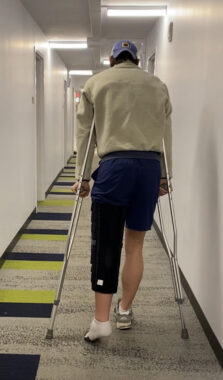How to prepare for knee surgery with a rare porphyria
My son's unexpected playbook: Balancing independence and his EPP needs

Life’s like a pickup basketball game — you never know when a twist or turn might change everything.
That’s the lesson we learned a couple of weeks ago with my son Brady, a freshman at Syracuse University who navigates life with erythropoietic protoporphyria (EPP), a rare condition that’s always present but not always visible. His EPP, which causes horrific pain when triggered by the sun and sometimes artificial lighting, wasn’t the main issue this time, but it still had a role to play.
One moment, Brady was dribbling down the court with his buddies; the next, he was on the floor with a torn ACL and medial meniscus, his leg painfully entangled with another player. In an instant, we were thrust into a new reality, navigating medical care, personal independence, and the complexities of living with EPP.
EPP has always been our invisible companion, lurking in the background as Brady navigates life. It doesn’t show up with flashing lights or obvious signs, but as anyone in the rare disease community knows, invisibility doesn’t equate to nonexistence. Further, even if a new doctor can’t see this disease, they should be aware of a person’s entire medical history as they make informed decisions that affect the patient’s healthcare.
Reactions and considerations
When the injury happened, I did what any mom would do: I flew up to Syracuse, New York, from my home in Maryland faster than you can say “emergency room.” We managed the initial medical rush and then revamped his dorm room for his new, temporary lifestyle on crutches.

Brady maneuvers on crutches in his college dorm. (Courtesy of Kristen Wheeden)
The real surprise came during our visit with the orthopedic surgeon. Brady, perhaps embracing his newfound college independence, didn’t think his EPP was relevant enough to share with this new doctor. Hold on, what?
Brady’s a pro at dodging the sun and sharing with others when he needs to be protected from it. But connecting the dots between EPP and the risks of surgery lights and tools was a new ballgame for him. As a patient advocate, I’ve offered guidance and resources from porphyria experts to countless others, but it hadn’t crossed my mind that Brady wouldn’t automatically discuss his condition with a doctor who’d perform surgery on him.
There we were in the doctor’s office, having a classic mom-son silent dialogue. I’m giving him the “you gotta tell him” look, and he’s shooting back a “why does this even matter now?” glare. Once we explained EPP to Dr. Knee Surgeon, who seemed to vaguely recall porphyria from a dusty corner of his medical school memories, we got down to details about EPP and surgery:
- Surgical lights can induce an EPP reaction, but filters can help.
- Laparoscopic tools have lights, but evidence shows they’re safe.
- Mild anemia and a vitamin D3 deficiency might be present in an EPP patient’s medical records.
- Any medications should consider that the liver needs to be protected.
There are even new consensus guidelines for patients with EPP and their healthcare professionals. They answer many questions related to the disease and are useful for anyone living with the condition.
In our newfound scenario, considering the surgery’s length, Brady’s comfort with artificial lighting, and expert advice that laparoscopic lights are EPP-friendly, we decided no special measures were needed. But wow, what an important chat to have had!
This experience was eye-opening for both of us. Brady is learning that independence also means being your own health advocate, especially with a condition that often flies under the radar. I realized that teaching independence with EPP isn’t just about handing over the reins; it’s about ensuring Brady knows when and why to speak up about his condition.
As he gears up for his surgery and the journey to recovery, it’s clear that each challenge is also a chance to grow, learn, and step into independence. Here’s to Brady and all the young adults out there learning to navigate their health and their lives on their own terms. You’re mastering it, and remember, we’re right here, ready to support and learn together.
Note: Porphyria News is strictly a news and information website about the disease. It does not provide medical advice, diagnosis, or treatment. This content is not intended to be a substitute for professional medical advice, diagnosis, or treatment. Always seek the advice of your physician or other qualified health provider with any questions you may have regarding a medical condition. Never disregard professional medical advice or delay in seeking it because of something you have read on this website. The opinions expressed in this column are not those of Porphyria News or its parent company, Bionews, and are intended to spark discussion about issues pertaining to porphyria.








Simon Leake
I have never told surgeons about my EPP and one time I had a prolonged wisdom teeth extraction and definitely felt burnt on the face afterwards which made the tooth pain worse. I also had endoscopy procedure that caused some internal pain I am sure. Thanks to your article I will definitely discuss it the next time I have any surgery.